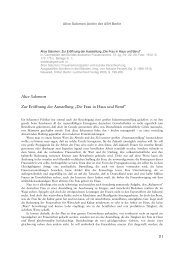Teaching Gender in Social Work - MailChimp
Teaching Gender in Social Work - MailChimp
Teaching Gender in Social Work - MailChimp
Create successful ePaper yourself
Turn your PDF publications into a flip-book with our unique Google optimized e-Paper software.
Many services and professions are concerned with women, social work<br />
be<strong>in</strong>g among them. Fem<strong>in</strong>ist social work 29 has contributed significantly to our<br />
understand<strong>in</strong>g of how social <strong>in</strong>equalities can be reproduced, which is of central<br />
importance to social work. <strong>Gender</strong> <strong>in</strong>equalities reveal that sexual difference is<br />
determ<strong>in</strong>ed by power relations, <strong>in</strong> accordance with which women are simply<br />
considered to be <strong>in</strong>ferior. In this sense, knowledge about the relations between<br />
the genders <strong>in</strong>forms our knowledge about how social <strong>in</strong>equality is reproduced.<br />
An awareness of power and authority has <strong>in</strong>fluenced social work <strong>in</strong> a manner<br />
that enables it to realise its professional potential <strong>in</strong> the process of regulat<strong>in</strong>g<br />
people’s lives on both collective and <strong>in</strong>dividual levels. An understand<strong>in</strong>g of<br />
the relation between the genders and the patriarchal structure of society has<br />
contributed to an awareness about the relations between professionals and<br />
users. The power is on the side of the professionals and is manifested <strong>in</strong> the<br />
fact that users are often deprived of the opportunity for self-representation.<br />
As people with problems they also lack the competence to make decisions<br />
about themselves, which is thus assigned to the professionals. The knowledge<br />
of professionals is privileged, whilst that of users is disregarded.<br />
Awareness of such relations has lead to a radical criticism of <strong>in</strong>stitutions<br />
and to a demand for the participation of users <strong>in</strong> the process of sett<strong>in</strong>g up social<br />
services. Women who were victims of violence themselves have started creat<strong>in</strong>g<br />
their own services (women’s shelters, advice centres) and establish<strong>in</strong>g new<br />
women’s spaces which have also become places of safety. They have advocated<br />
for establish<strong>in</strong>g community services and po<strong>in</strong>ted to the areas neglected by<br />
traditional social work: domestic violence, sexual abuse, rape, etc. Community<br />
social work has therefore become a new response to human distress, which<br />
is capable of br<strong>in</strong>g<strong>in</strong>g professionals »from the offices to the field« – <strong>in</strong>to the<br />
community, which is where the problems emerge. The manner <strong>in</strong> which a<br />
problem is embedded with<strong>in</strong> a certa<strong>in</strong> set of relations has become more<br />
important than the problem itself. Individual treatment no longer sufficed for<br />
the solv<strong>in</strong>g of the problem, and the new situation has called for social action<br />
which, <strong>in</strong>stead of just focus<strong>in</strong>g on people with problems, should also be aimed<br />
towards the chang<strong>in</strong>g of the system.<br />
As regards the relations between professionals and users, it was revealed<br />
that it is the exist<strong>in</strong>g relations of power and the understand<strong>in</strong>g of human distress<br />
29<br />
Lena Dom<strong>in</strong>elli, Fem<strong>in</strong>ist <strong>Social</strong> <strong>Work</strong> Theory and Practice. (Houndmills: Palgrave, 2002).<br />
101














